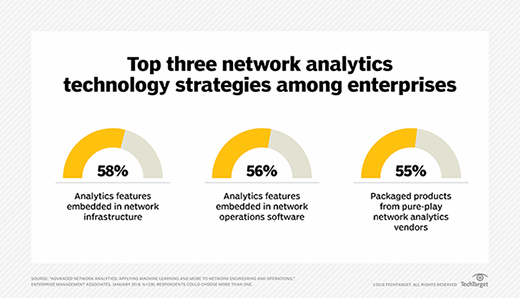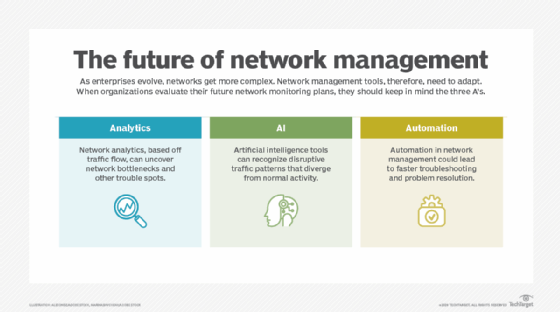What is network analytics?
Network analytics is the application of big data principles and tools to the data used to manage and secure data networks. By collecting and analyzing network data with an automated analytics application, IT admins and decision-makers can identify issues related to a network's security, reliability or performance, and determine what steps are needed to improve those aspects.
What is the purpose of network analytics?
Network analytics provides deeper insight into how an organization is using its network and how the network is performing. IT can use analytics to improve security, fine-tune performance, troubleshoot subtle problems, predict traffic trends, spot potential trouble and perform deep forensic investigations and audits.
In the past, analysts would manually collect network data from multiple sources, such as network devices, switches and servers. The data might've been related to data speeds, latency, congestion and so on. Today, many traditional network analytics processes are automated, allowing for easier and deeper analyses and faster resolutions to operational issues. In addition, some analytic applications are augmented with artificial intelligence (AI) to enable the creation of highly intelligent networks that can both identify and resolve problems, as well as self-configure or self-optimize based on evolving conditions or circumstances.
Benefits of network analytics
Enterprise networks have become more complex with increasing numbers of interconnected devices, in addition to connections to the open internet. These developments create new attack pathways that expand the attack surface and increase an organization's risk of cyberattacks. Too many devices, applications and data sources can also affect network quality of service (QoS), business productivity and user experiences. Proactive network monitoring and analysis can help organizations to mitigate these issues early.
Network analytics can deliver effective long-term security benefits. By monitoring network traffic and device behaviors, network analytics can detect anomalies that might indicate the presence of threats. In doing so, it provides an early warning system that allows security personnel to take preemptive actions against viruses, malware, advanced persistent threats (APTs) and others.
Another key benefit of network analytics is that it increases visibility into a network and enables network managers and admins to get detailed insights into what's working well on the network and what's not. These insights, along with specific recommendations and guidance also provided by the application, can help guide their actions and decisions regarding issue remediation and the optimization of network performance, resource allocation and user experiences.
Some advanced systems can even perform closed-loop remediations to automatically apply fixes to identified issues. Such automated corrective actions are beneficial in terms of improved network performance, QoS and security. They also allow IT teams to focus their time and energy on other high-priority issues where their unique human capabilities -- judgment, critical thinking, decision-making and so on -- can deliver the biggest benefits to the organization.
Network analytics also benefits organizations looking to optimize their business processes. The insights from analytics tools can be combined with the insights from other business tools (e.g., procurement or purchasing applications) to determine opportunities for process improvements and optimizations.
Network analytics use cases
Network analytics provides useful insights that allow network managers to get visibility into enterprise networks. This visibility is crucial for identifying congestion and bottlenecks, and for performing root cause analyses. They can also use the insights to investigate security gaps or lapses, evaluate the health of devices on the network and to remediate issues before they can cause an adverse impact on operations or users.
IT teams, admins and managers can also use network analytics to enhance performance and ensure that it meets a desired benchmark. By comparing real-time incoming network data with preprogrammed models of ideal network performance, network analytics solutions can identify undesirable deviations or anomalies. More importantly, the analytics app can recommend actions that might eliminate the anomalies and improve network performance and reliability.
Network analytics is also crucial to building a zero-trust environment. Zero-trust architectures require a way to close the loop between policy and observed network behavior. Analytics solutions that look for bad network behavior and anomalies close that loop, thus helping organizations eliminate the security gaps created by traditional castle-and-moat cybersecurity and strengthening their security posture.
How does network analytics work?
A network analytics solution collects and aggregates real-time data from the network and its various elements, including endpoints, hosts, servers, switches and so on. When collecting data from devices, it might use multiple protocols like NetFlow, traceroute and Simple Network Management Protocol, or SNMP. It might also include many kinds of server sources like syslog, Active Directory, RADIUS and DHCP, and use different ways to collect the data and build a contextual, usable database of information. Common methods include deep packet inspection (DPI) and streaming telemetry.
After collecting data, the analytic application identifies useful patterns and correlations that can then help teams take appropriate actions and make decisions to improve network security and performance. Moreover, by collecting data from multiple sources, the application can provide a detailed and multidimensional picture of the state of the network. This picture is crucial to help IT teams to monitor the entire network, quickly detect security threats in any part and improve the security of all connected devices.
Powerful analytics solutions automatically and continuously compare the current state of a network with a model of optimal performance. If a deviation is detected, an alarm is raised so teams can investigate further. For example, unusual traffic on an endpoint device might indicate that it has been infected with malware. The application might detect such traffic and present its findings so that decision-makers can review the findings and take the appropriate actions.
Context is important when collecting data because it enables the application to understand the underlying network conditions and specific circumstances before flagging a potential anomaly. This minimizes the chances that it will be a false positive, so network teams are less likely to waste time or effort.

Network analytics for predictive analysis
Predictive network analytics is another important application that is of particular interest to network and security operations personnel. By harnessing AI techniques such as machine learning, network analytics tools steadily improve at predicting future issues based on current environmental data. These newer techniques enable tools to ingest and correlate more data of more types from more sources. This, in turn, powers major improvements in the tools' ability to understand the normal behaviors of network entities -- whether hardware, software or human -- and to extrapolate likely changes in that baseline. They supplement historical trending with projections of future trending.
The newer capabilities can also power better detection of anomalous behavior, potentially indicating misconfiguration, current or incipient malfunction in a system, or current or incipient attacks. Such tools can provide predictions of likely future issues. They can interpret the gradual degradation of performance in a device, such as an upcoming failure in a network interface card.

Requirements for network analytics
To take advantage of network analytics, enterprises need infrastructure capable of producing network performance and usage data, both low-level and high-level. That data includes the following:
- Bit rates through a particular physical network port.
- Collision and packet drop rates at a port.
- Latencies for traffic through a port.
- Number of packets or flows affected by specific security policies.
- Number of packets or flows originating from or to any given entity, including location, device, application or identity.
Enterprises also need centralized systems to collect, store and analyze this enormous amount of information used by analytic apps.
To be useful, network analytics needs all the user-facing accoutrements of other big data initiatives: ad hoc querying and reporting, dashboards, and flexible and interactive visualization tools for exploring relationships, trends over time and anomalous events. Such tools must either be embedded in the analytics app or the app must be able to integrate with key network management systems to enable activities such as sending events to a network operations center console or a zero-trust policy engine.
Users of network analytics
One major factor driving the growing use of network analytics is the orders-of-magnitude increase in the number of entities on a typical network. The continuing rise of internet of things (IoT) and the spread of software as code and microservices in cloud services and data centers cause the number and variety of entities on the network to rapidly increase. Analytics is critical to provide comprehensive management and security in environments that grow more complex.
Network analytics is most useful to organizations with complex networks, overtaxed networks or high-level security requirements. As a result, large enterprises are more likely than smaller companies to use network analytics broadly.
That said, network analytics tools are becoming more standardized and easier to use. Some of them are embedded in more managed services, further simplifying adoption and use. Costs are also falling, which is why more companies with smaller networks are increasingly using network analytics to analyze and optimize network operations. Also, the emergence of cloud-hosted analytics enables organizations to access more processing power and scale for their analysis requirements without substantially increasing costs.
In general, all sizes of companies are now able to implement network analytics as a built-in feature of cloud-managed network services, such as a network-as-a-service offering, managed software-defined wide area network, i.e., WAN, or managed wireless LAN service.
Predictive analytics can project network traffic flows, predict future trends and reduce latency. Explore how predictive analytics can help network operations.







